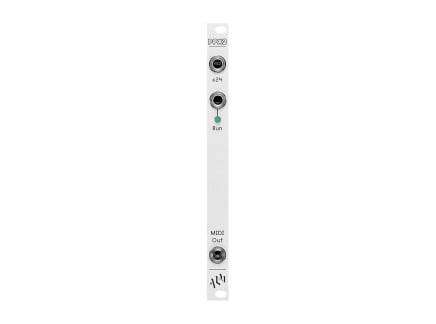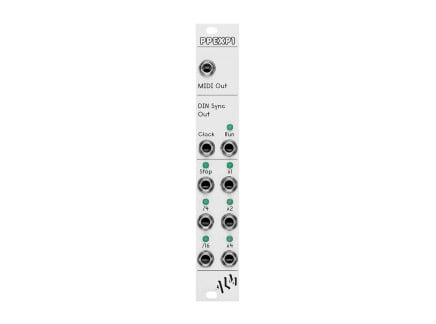Editor's note: this article was published in the heyday of Pamela's New Workout—one of the most important and popular Eurorack modules of all time. Now, however, we're in a new age: an age where the Pamela's Pro Workout has taken center stage. Pamela's Pro Workout is capable of everything that Pamela's NEW workout could do and more, so keep in mind that all of these tips apply to both models equally. That note aside, for posterity's sake, we've left this article otherwise unaltered—so, whether you're still getting to know your classic PNW or you've recently acquired a Pro Workout, we hope you'll find these tips and tricks useful!
ALM Busy Circuits's Eurorack module Pamela's New Workout isn't exactly a secret—in fact, it's one of the most popular Eurorack synthesizer modules of all time, sitting comfortably along Make Noise's Maths in terms of sheer flexibility and versatility. A veritable Swiss army knife of functionality, Pam's New Workout is a powerhouse for modulation and clocking. With eight independently customizable outputs, it can distribute tempo-synced clocks, LFOs, random voltages, and all flavors of modulation across an entire system: acting as a "brain" that brings life to even the smallest of systems and turns disparate sets of modules into unified instruments.
In our experience, most people seem to use Pam's New Workout (PNW) as a tool for clocking, clock division/multiplication, and tempo-synced LFOs—and by all means, those are excellent uses! Being able to tie together up to eight clocks/modulation signals related to a single unified tempo means that it's easy to keep your system feeling like it has a unified sense of pulse/tempo even when you're using multiple sound sources. However, PNW goes much deeper than just that; and as such, we wanted to share some of our other favorite tips and tricks for getting the most out of Pam's.
Let's take a look at three of our favorite workouts: using PNW as a quantizer, as a Euclidean rhythm generator, and using it to create logic-derived rhythmic variations. Be sure to check out our video above for specifics about how to achieve these functions, and read on for an overview of what these tricks allow you to do.
Tip 1: Pam's New Workout as a Quantizer
Pam's quantization functions are an absolute joy and, from our perspective, one of its most interesting and under-utilized features. Using this feature, it becomes possible to use PNW like a pseudo-sequencer, producing tempo-synced arpeggios, bass lines, and peculiar melodies.

One particularly interesting feature of PNW's method of quantization is that quantization can be arbitrarily applied to any output—so you can basically force LFOs, random waveforms, etc. to lock to quantized pitch values at 1V/octave. This turns sine wave LFOs, for instance, into arpeggios/scales with upward and downward melodic movement; saw LFOs will ramp continuously up or down chord/scale shapes; random LFO shapes generate random melodies, etc. In fact, you can even dial in your desired output range up to 0–5V—allowing you to limit your melodic range for more subtle melodies and arpeggios.
With a wide selection of scales and chords available, this makes it downright easy to create up to eight channels of simple sequence-like behaviors, all synced to a single underlying tempo and without the need for an external quantization module. So if you're looking for a straightforward source for algorithmic melody generation or polyrhythmic sequencing Pam's is a solid contender.
Another quick note—you can actually use the CV inputs to modulate the quantization functions as well. You can use an external CV source to modulate the output's melodic range, for instance, allowing for melodies that change shape and range over time. Perhaps more interestingly, you can also use an external CV to apply a pre-quantization offset—allowing you to use Pam's as a quantizer for external CV. This means that it's possible to use Pam's for a huge range of melodic purposes—so despite the fact it's often thought of as a clocking tool, don't let yourself get be fooled into thinking it can't handle pitch-related duties as well!
Tip 2: Pam's New Workout as a Euclidean Rhythm Generator
An old favorite trick on the original version of Pam's Workout was an alternate firmware that allowed for the creation of Euclidean rhythms. This is a great option for breaking away from straightforward clocking patterns and into more exciting, unpredictable, and off-kilter pattern generation. Pamela's New Workout integrates this feature, allowing for Euclidean masking of steps—allowing a wide range of Euclidean rhythm and modulation generation.
Like many Euclidean sequencers, PNW allows you to choose a number of steps ("Estep," the total number of clock cycles in your trigger pattern), the number of active steps ("ETrig," the number of trigger events to be distributed across your pattern), and "rotation" ("ERot") for the trigger pattern, allowing you to shift the trigger pattern any number of steps. This is a great way to create polyrhythms and unpredictable combinations of rhythms across different channels—breaking free from the typical 4/4 "grid" and providing a more fluid, evolving rhythmic framework for your patches. Often, by using prime numbers or otherwise unrelated numbers (for instance, seven steps with three triggers, 11 steps with five triggers, etc.) you can create bouncy, evolving, and straight-up fun rhythms.
Talking about Euclidean rhythmic strategies as a whole exceeds the scope of this article—but just know that if you're looking for a powerful all-in-one Euclidean event generator with a load of other tricks up its sleeve, Pam's is a stellar option that takes up very little space compared to its alternatives. Combined with its other humanization and randomization options, this can be a great way to bring life and quirky pattern generation to any modular system.
Tip 3: Pam's New Workout as a Logic-Based Rhythm Generator
Our last tip for now involves PNW's internal logic functionality. As with Euclidean sequencing, discussion of logic is a bit beyond the scope of this article—but do check out our article Learning Synthesis: Logic for a better idea of what logic is and how it can be used for musical purposes.

In short, each channel of Pam's can employ a simple Boolean logic filter before its output, allowing you to create logical combinations of any two channels at any channel's output. This means that you can compare two different independent clock streams and create a stream of gates that uses logical rules to create gate patterns rather than just simple, straightforward clocks. For instance, AND logic will only produce a gate if both of the compared channels are high; OR logic produces a gate if either or both of the channels are high; and XOR logic produces a gate only if one or the other channel is high (but not both).
Depending on the relative rates of the compared channels, this can yield a huge range of outcomes both rhythmic and structural. For instance, establishing an AND relationship between a sixteenth-note pulse and a half-note pulse at 50% duty cycle will result in groups of four sixteenth notes with a beat of rest between them, creating a sense of structure within a phrase. Longer clocks can result in phrase-level changes, and shorter clock comparisons can create odd, shuffled rhythms and polymeter. Logic is great for creating unexpected rhythms through experimentation—and especially when combined with the Euclidean functionality described above, you can use it to go a long way creating exciting, evolving, and steady-yet-unpredictable rhythmic structures.
The Tip of the Iceberg
This is only a little bit of what Pam's New Workout can do. Like any module worth its salt, it provides a seemingly endless combination of tricks that can be used for sequencing, rhythm generation, modulation, and much more. Changing shape from use to use and system to system, there's no wonder it has become such a well-loved tool in the Eurorack world: it turns any modular system into a highly flexible and organized ecosystem, and it's hard to imagine a system that couldn't benefit from using one.
Of course, there's much more to Pam's New Workout than Euclidean sequencing, logic, and quantization—so keep your eyes peeled for more ideas about how to get more out of your Pam's New Workout!










